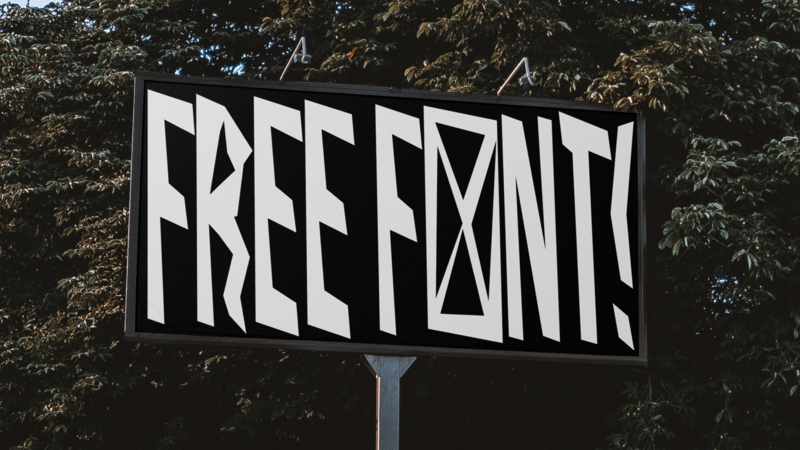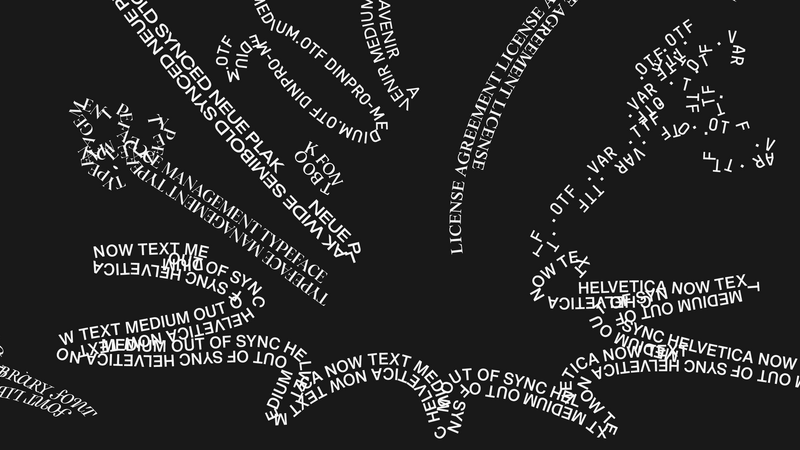Complete guide to font licensing.

Font management
Font legibility
Brand fonts
Font licensing
What is Font Licensing?
Licensing isn't the most glamorous aspect of typography, but since every font file is entitled to intellectual property protection, it's just as important as choosing the right fonts for your project.
Font licensing refers to the legal agreements that govern the use of font files. Font foundries create license agreements that outline the terms and conditions for font use, typically covering the following details:
- The number of users who can install and use the font
- Permitted methods of installation and usage (e.g., on computers, on websites, or in PDFs)
- Whether the font can be distributed or shared with others
- Permissions for modifying or altering the font files
- Whether the font is for personal or commercial use
- The duration of the license agreement (whether it is perpetual or limited, with possible requirements for renewal or fees)
Understanding these specifications is essential to ensure compliance and avoid unwanted complications when using fonts in your design projects.
Do I need font licenses?
If you're a designer, marketer, or other professional working with fonts, your work almost certainly requires you to obtain font licenses. Fonts are software, so whenever you purchase or install a font on your computer, you should also be obtaining the license to use it according to the terms established by the creator.
Fonts are painstakingly drawn over months (or even years!) and are engineered to perform perfectly in a range of contexts. Font licenses exist to ensure that artists are appropriately compensated for their hard work. When you obtain a font license, you’re legally permitted to incorporate the font into your designs, whether it be for personal or commercial purposes. Font management becomes extremely important here.
It's important to note that font licensing varies depending on the font foundry, creator, or distributor. Some fonts may be available for free or under open-source licenses that allow unrestricted usage, modification, and distribution. However, free fonts often come with significant downsides. Even established sources can alter or delete open-source fonts at any time. Some open-source font libraries tinker with their fonts, without checking for quality or consistency. If a library adjusts a font’s spacing or kerning, the pages and apps using that font can break. To avoid this, most creatives prefer to purchase fonts from established foundries and creators.
Professional-grade fonts come with their own licensing terms. When you purchase a font, make sure you’re paying for licensing terms that cover your intended use case. There are a variety of font licenses that govern the usage of fonts; next, we’ll review the most common types.

What are the most common types of font licenses?
Font licenses outline the conditions and restrictions for font use, modification, and distribution. Some of the most common font licenses include:
Open font licenses.
Many open-source fonts come with an SIL Open Font License (OFL), which gives users the freedom to modify, distribute, and use the fonts for any purpose, without any restrictions. These kinds of fonts are often free. Their licenses may stipulate that modified versions of the fonts be released under the same open-source license.
Web font licenses.
Web fonts are licensed specifically for use on websites and in web applications. Web font licenses allow users to embed fonts into web pages using CSS, ensuring they’re displayed properly across different browsers and devices. Web font licenses may include limitations on the number of page views or unique visitors, as well as on domains where the font can be used.
Commercial licenses.
If you’re planning to use fonts for commercial projects like advertising, branding, or product packaging, you’re going to need commercial licenses. These licenses vary in their usage restrictions, such as the number of users or devices allowed and the scope of usage (e.g., print, web, or mobile).
Desktop licenses.
Desktop fonts are licensed specifically for use with desktop applications like design software and word processors. Desktop licenses may restrict use to specific computers or devices, or stipulate how many users can create prototypes and personal designs using a given font.
App licenses.
Fonts designed for use in mobile applications often come with specific licensing terms, which may limit the number of installations or restrict use of the font in certain apps.
Embedding fonts.
Some font licenses allow font embedding, which means including the font files within a document or file. These licenses may also restrict the file formats or the contexts in which you can embed the font.

How do I transfer a font license?
Transferring a font license involves transferring the rights and permissions granted under the license from the current license holder to another individual or entity. The specific processes and requirements for transferring a font license vary depending on the terms and conditions set by the font's licensor.
Here’s what you should remember to do when transferring font licenses:
Review the license agreement.
Look over the license agreement for any restrictions against or requirements for license transfers. Pay special attention to license transferability, permitted transferees, and other procedures required before the transfer.
Contact the licensor and obtain permission.
Reach out to the font's licensor or the authorized distributor with an inquiry regarding font license transfer procedures. They should be able to provide you with the information you need, including guidelines and required documentation.
Afterwards, obtain the permission of the licensor to transfer the license. Some licenses may require written consent or a formal request to initiate the transfer process.
Identify the transferee.
Ensure that the individual/entity receiving the font license meets all the licensor’s criteria, and make sure that the transferee understands the usage scenario defined in the license (e.g., personal or commercial).
Document the transfer.
Prepare a written agreement or document stating the details of the license transfer. Include information like the font's name, its version, and the specific rights being transferred. Both the current license holder (transferor) and the new license holder (transferee) should sign the document to officially acknowledge the transfer.
Notify the licensor.
Inform the licensor about the completion of the license transfer. Provide all relevant documentation per their instructions. The licensor may require copies of the transfer agreement and other relevant details to update their records and confirm the transfer’s validity.
Update your records.
Your records should reflect the new license holder’s name and contact details. Make sure you store any associated documents.
These steps are general guidelines—the specific requirements for transferring a font license may vary depending on the font's license agreement. If possible, enlist a legal professional to double-check all associated documents and conditions.
How much do font licenses cost?
The cost of font licenses varies depending on numerous factors, including:
Font type.
Open-source fonts are free and have minimal usage restrictions. Free fonts provide limited options and can cause issues down the line. High-quality commercial fonts aren’t free, but because they’re professionally designed, you can rest assured you’ll receive stunning fonts that elevate your designs. You’ll also get a broader range of characters, as well as customer support.
Scope of usage.
A font’s use case can also impact its cost. Fonts designated for exclusively personal use are generally more affordable than fonts licensed for commercial use. Commercial licenses may have different pricing tiers based on factors like the number of users, devices, or locations where the font will be utilized.
Licensing duration.
The price also varies depending on the length of time you’ll need to use the font. Some licenses are one-time purchases with perpetual usage rights, while others may follow subscription models and require recurring payments.
Foundry or designer.
Well-established, renowned, and award-winning font designers and foundries often charge more for their fonts because they're handcrafted by experts with years of experience. For more affordable options, look for fonts from independent designers or smaller foundries.
Additional features and support.
Some font licenses include additional features, such as different font weights, variations, or extended character sets, that contribute to a higher price. Fonts that come with technical support or additional services, such as customization or consulting, may also be priced accordingly.
Given the wide range of font options and licensing models available, it is difficult to provide a specific price range for font licenses. We recommend looking into known font marketplaces and foundry websites, or contacting font designers or distributors directly to obtain pricing information for specific fonts you are interested in. Additionally, font licensing terms and pricing may change over time, so it's important to verify the most up-to-date information when considering font licensing costs.
What happens if I use a font without a license?
When you use a font without obtaining the necessary license, you may be infringing on the font creator's intellectual property. The font creator or their authorized representatives are well within their rights to make a copyright claim. You may be required to cease using the font immediately—you’ll have to re-do all your brand assets and start from square one.
The worst case scenario? You may be held liable for damages, including financial penalties.
On top of potential legal issues, unauthorized use of a font can harm your brand. If the font creator discovers that you are using their font without permission, they may publicly call attention to the infringement, damaging your brand’s credibility. This negative publicity can leave a long-lasting negative impact on your potential partnerships and revenue.
How can I simplify font licensing?
Making sure that all the fonts that you’re using are properly licensed can be overwhelming at first. Good news: there’s a way to do this without drowning in paperwork and spending endless hours on administrative tasks.
Monotype Fonts’ subscription-based model simplifies the entire process.
Access 250,000+ fonts and use as many mockups as you need.
Our extensive font collection of more than 250,000 fonts and counting provides a diverse selection of typefaces for your projects. Gain access to a wide range of high-quality fonts from Monotype and other renowned foundries, and use them for as many prototypes and mock-ups as you need.
Licensing, simplified.
Licensing is built into every Monotype Fonts plan. Instead of juggling individual licenses for all your fonts, simply select a subscription plan that covers all your intended use cases. You’ll only need to keep track of one document.
Our licensing terms cover a wide range of scenarios, including personal projects, commercial use, web embedding, and app integration. This allows you to utilize your chosen fonts across various mediums and platforms. You’ll have access to customer support, too, so if you have any doubts regarding compliance, the answer is always just a click away.
Regular updates and new releases.
You’ll have access to the latest releases from the world’s best foundries right on your dashboard. Test fonts as you type and use the trendiest new fonts for your prototypes.
Easy-to-use UI.
Our platform's intuitive interface streamlines font license management. You can easily view and track the fonts you have licensed, access usage details, and make adjustments or additions as needed.

Monotype Fonts simplifies font licensing so you can focus on creativity. Visit our subscription page to select the right plan for your needs.